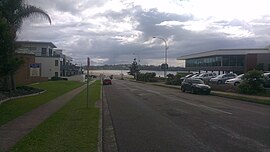Mollymook, New South Wales
|
Mollymook New South Wales |
|||||||
|---|---|---|---|---|---|---|---|

View of Mollymook Beach from Golf Avenue
|
|||||||
| Population | 1,184 (3,246 including Mollymook Beach) (2011 census) | ||||||
| Postcode(s) | 2539 | ||||||
| Elevation | 19 m (62 ft) | ||||||
| Location | |||||||
| LGA(s) | City of Shoalhaven | ||||||
| State electorate(s) | South Coast | ||||||
| Federal Division(s) | Gilmore | ||||||
|
|||||||
Mollymook is located on the South Coast of New South Wales, Australia approximately three hours' drive south of Sydney within the City of Shoalhaven local government area. At the 2011 census, Mollymook had a population of 1,184 while the adjacent locality of Mollymook Beach is home to a further 2,062 people. Geographically, Mollymook is considered part of the Milton-Ulladulla district, a coastal corridor of urban development stretching from Burrill Lake, south of Ulladulla to Mollymook's northern neighbour, Narrawallee and the historic town of Milton a few kilometres inland.
The area collectively referred to as Mollymook is formed by two distinct localities; Mollymook Beach - a mostly residential area incorporating Bannister Headland adjoining Narrawallee, and Mollymook - containing the Mollymook golf and surf lifesaving clubs, motels and serviced apartments. The name "Mollymook" is believed to be a corruption of mollymawk, the name given by sailors to small species of albatross.
Mollymook was first settled as a rural area of Ulladulla. In 1859, the Mitchell family established a property named "Molly Moke" in the vicinity of Garside Road. "Mollymook" is possibly a reference to the black-browed mollymawk. A cemetery overlooking the sea was in use by 1893. Some time around 1900, John Coller allowed public access to the beach and rock pools on his family estate (present day Collers Beach), and Mollymook began to earn a reputation as a popular retreat. Silica mining operations were commenced on Mollymook's southern headland by the Illawarra brick company prior to 1920 and brought an influx of workers to the quarries. Bannister Headland at the northern end of Mollymook beach was the site of a silica crushing facility and loading jetty in the early 20th Century. In 1924, a tramway was constructed across Narrawallee Inlet to transport silica from mining leases near Conjola for preparation and shipping. The industry declined during World War II. During the 1990s, many of Mollymook's older homes began to be redeveloped with medium density apartments and resort style hotels. Like much of the south coast, the town is popular with retirees.
...
Wikipedia
